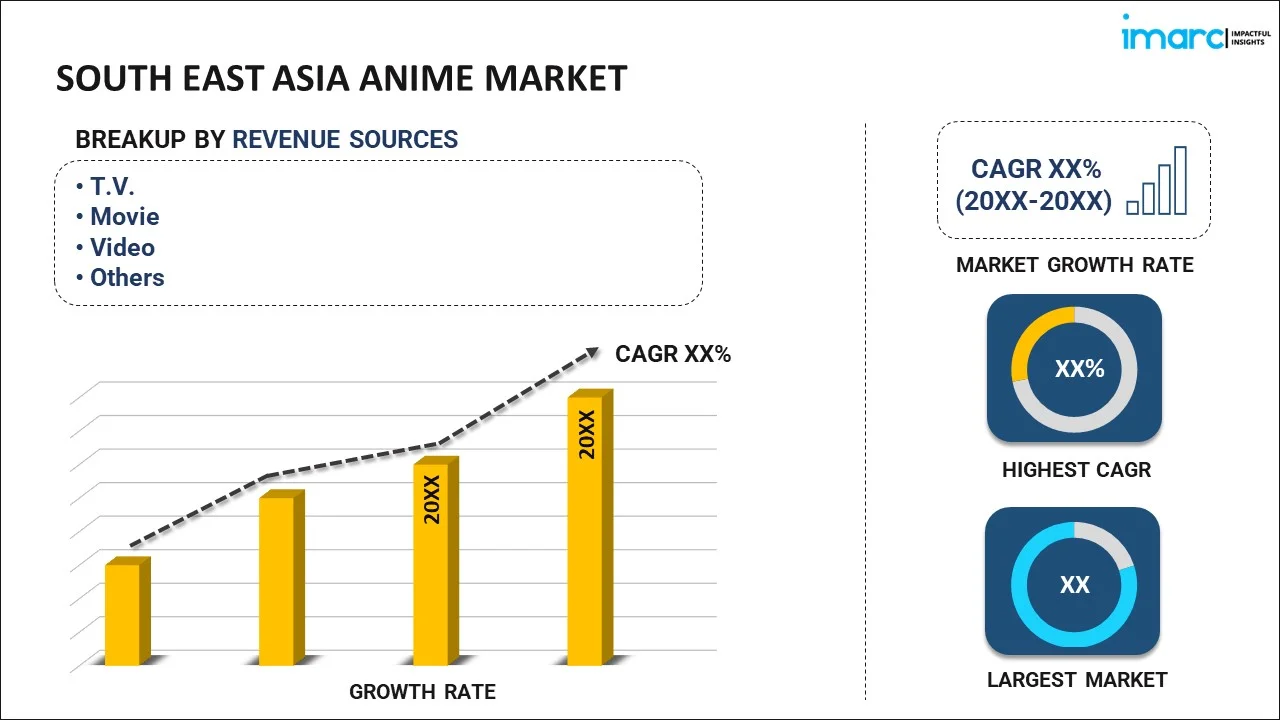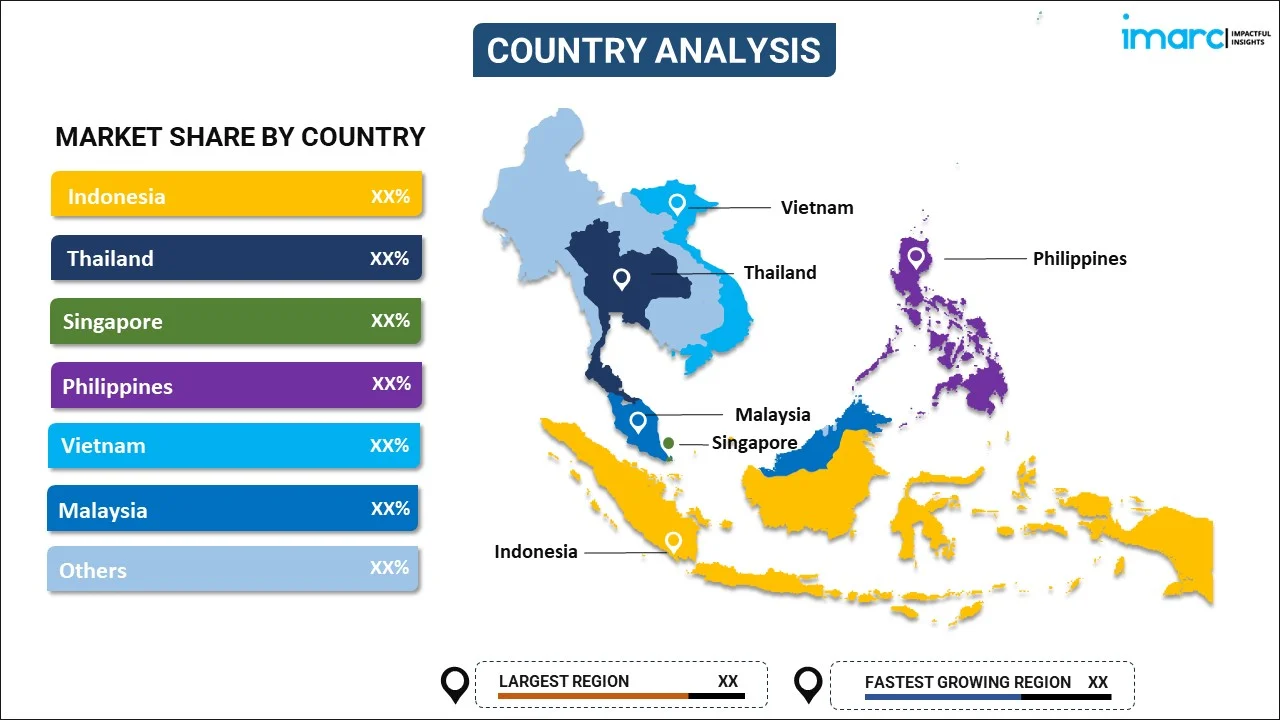
South East Asia Anime Market Report by Revenue Source (T.V., Movie, Video, Internet Distribution, Merchandising, Music, Pachinko, Live Entertainment), and Country 2025-2033
Market Overview:
South East Asia anime market size is projected to exhibit a growth rate (CAGR) of 8.4% during 2025-2033. The increasing availability of anime through various streaming platforms and online services, which has made it more accessible to audiences, is driving the market.
|
Report Attribute
|
Key Statistics
|
|---|---|
|
Base Year
|
2024 |
|
Forecast Years
|
2025-2033
|
|
Historical Years
|
2019-2024
|
| Market Growth Rate (2025-2033) | 8.4% |
Anime refers to a style of animation that is characterized by its colorful artwork, fantastical themes, and vibrant characters. It covers a diverse range of genres, including action, romance, science fiction, fantasy, and horror. Its artistic style often features exaggerated facial expressions, emotive character designs, and intricate attention to detail in both the background and foreground. While some anime series and films are created for a younger audience, others explore complex and mature themes, appealing to a broader demographic. Anime has significantly evolved over the years, incorporating various technological advancements to enhance its visual and storytelling aspects. It has established a dedicated fanbase and has influenced numerous other forms of media, including video games, music, and fashion. Notable examples of anime include classics like Naruto, Dragon Ball, and Sailor Moon, as well as more recent hits such as Attack on Titan and My Hero Academia.
South East Asia Anime Market Trends:
The anime market in South East Asia is thriving, primarily driven by several factors. Firstly, the growing regional fan base has propelled the demand for diverse content, resulting in an upsurge in production and distribution. Consequently, streaming platforms have capitalized on this trend, providing a convenient and accessible way for viewers to engage with their favorite series. Moreover, technological advancements have facilitated the creation of visually stunning animations, captivating audiences with their intricate details and vibrant aesthetics. Additionally, the proliferation of social media has fostered a dynamic community where enthusiasts can actively participate in discussions, fueling the buzz around upcoming releases and contributing to the overall hype. Furthermore, the expansion of merchandising and licensing opportunities has allowed companies to leverage popular characters and storylines, establishing a multi-faceted revenue stream that extends beyond the screen. Overall, these interconnected drivers have fostered a robust ecosystem, ensuring the enduring popularity and continuous growth of the anime market in South East Asia during the forecast period.
South East Asia Anime Market Segmentation:
IMARC Group provides an analysis of the key trends in each segment of the market, along with forecasts at the regional and country levels for 2025-2033. Our report has categorized the market based on revenue source.
Revenue Source Insights:

- T.V.
- Movie
- Video
- Internet Distribution
- Merchandising
- Music
- Pachinko
- Live Entertainment
The report has provided a detailed breakup and analysis of the market based on the revenue source. This includes T.V., movie, video, internet distribution, merchandising, music, pachinko, and live entertainment.
Country Insights:

- Indonesia
- Thailand
- Singapore
- Philippines
- Vietnam
- Malaysia
- Others
The report has also provided a comprehensive analysis of all the major regional markets, which include Indonesia, Thailand, Singapore, Philippines, Vietnam, Malaysia, and Others.
Competitive Landscape:
The market research report has also provided a comprehensive analysis of the competitive landscape. Competitive analysis such as market structure, key player positioning, top winning strategies, competitive dashboard, and company evaluation quadrant has been covered in the report. Also, detailed profiles of all major companies have been provided.
South East Asia Anime Market Report Coverage:
| Report Features | Details |
|---|---|
| Base Year of the Analysis | 2024 |
| Historical Period | 2019-2024 |
| Forecast Period | 2025-2033 |
| Units | Billion USD |
| Scope of the Report | Exploration of Historical and Forecast Trends, Industry Catalysts and Challenges, Segment-Wise Historical and Predictive Market Assessment:
|
| Revenue Sources Covered | T.V., Movie, Video, Internet Distribution, Merchandising, Music, Pachinko, Live Entertainment |
| Countries Covered | Indonesia, Thailand, Singapore, Philippines, Vietnam, Malaysia, Others |
| Customization Scope | 10% Free Customization |
| Post-Sale Analyst Support | 10-12 Weeks |
| Delivery Format | PDF and Excel through Email (We can also provide the editable version of the report in PPT/Word format on special request) |
Key Questions Answered in This Report:
- How has the South East Asia anime market performed so far and how will it perform in the coming years?
- What has been the impact of COVID-19 on the South East Asia anime market?
- What is the breakup of the South East Asia anime market on the basis of revenue source?
- What are the various stages in the value chain of the South East Asia anime market?
- What are the key driving factors and challenges in the South East Asia anime?
- What is the structure of the South East Asia anime market and who are the key players?
- What is the degree of competition in the South East Asia anime market?
Key Benefits for Stakeholders:
- IMARC’s industry report offers a comprehensive quantitative analysis of various market segments, historical and current market trends, market forecasts, and dynamics of the South East Asia anime market from 2019-2033.
- The research report provides the latest information on the market drivers, challenges, and opportunities in the South East Asia anime market.
- Porter's five forces analysis assist stakeholders in assessing the impact of new entrants, competitive rivalry, supplier power, buyer power, and the threat of substitution. It helps stakeholders to analyze the level of competition within the South East Asia anime industry and its attractiveness.
- Competitive landscape allows stakeholders to understand their competitive environment and provides an insight into the current positions of key players in the market.
Need more help?
- Speak to our experienced analysts for insights on the current market scenarios.
- Include additional segments and countries to customize the report as per your requirement.
- Gain an unparalleled competitive advantage in your domain by understanding how to utilize the report and positively impacting your operations and revenue.
- For further assistance, please connect with our analysts.
 Inquire Before Buying
Inquire Before Buying
 Speak to an Analyst
Speak to an Analyst
 Request Brochure
Request Brochure
 Request Customization
Request Customization




.webp)




.webp)












